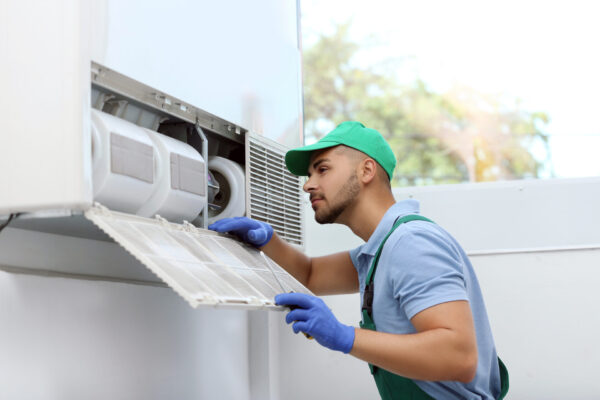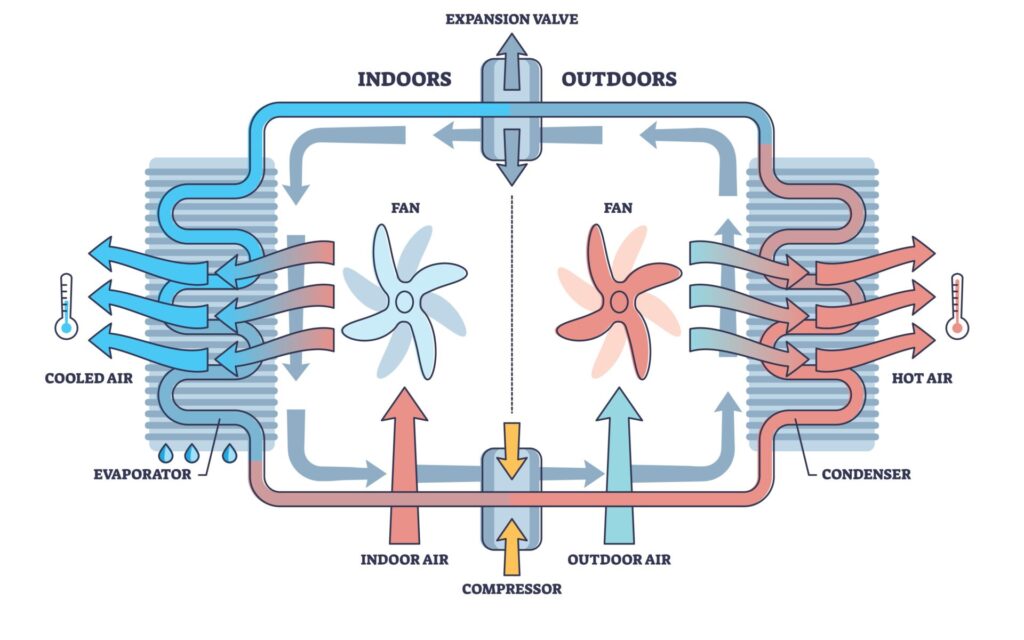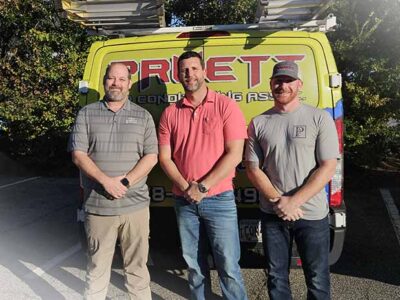
We’re getting closer to the end of another long, hot Middle Georgia summer. If you’ve spent the last few months of sweltering heat in comfort, you probably have an air conditioner to thank. (Or you’ve been drinking a LOT of iced tea.)
Air conditioning is practically a necessity for life in Middle Georgia or anywhere else where the climate chooses to imitate a convection oven for several months out of the year. For more than 100 years, those of us who elect to live in places like Middle Georgia have relied on electrically powered evaporative cooling systems to make summers more bearable.
So long as your air conditioning is pumping out plenty of cool, dry air, you may not have spent much time pondering how it works. But if you’ve ever been curious, this month’s article will answer the question: how does an air conditioner work?
How An Air Conditioner Works, Pt. 1: Managing Heat
The first thing you need to understand is that there is no such thing as cold. What we call “cold” is really just “the opposite of heat.” When anything makes something else cooler, it does so by removing heat from it.
And at its most basic, that’s all an air conditioner does: it removes heat from air and then blows that air into your home or business. You could get the same effect by blowing a fan across a large block of ice (in fact, early “air conditioners” did just that, as did the classic kitchen icebox) – the ice removes heat from the air passing over it.
What makes electrical air conditioning unique is how it manages the heat. In the block-of-ice example above, it’s easy to see where the heat goes: it melts the ice (and leaves a big puddle on the floor). In most electrical air conditioners, however, the heat goes into evaporating a particular substance known as “refrigerant” (also known as Freon, Puron, and a dozen other different names), which is why we call it “evaporative cooling.”

How An Air Conditioner Works, Pt. 2: Evaporation Is (Kinda) Magic
Our bodies know all about evaporative cooling. It’s the entire reason we sweat when we get hot: to use the evaporation of our sweat as a kind of natural air conditioning.
See, evaporation is kind of magical. All substances must absorb a tremendous amount of heat in order to change from a liquid to a gas. Think about a pot of water sitting on a stove, slowly reaching the boiling point of 212 degrees Fahrenheit. Imagine that the amount of heat needed to raise the temperature of the water from 211 degrees to 212 degrees is… let’s call it one Pruett Heat Unit.
Converting that same water from liquid at 212 degrees to steam at 212 degrees requires six Pruett Heat Units.
So whenever a liquid evaporates – no matter what causes that evaporation – it pulls a massive amount of heat from the surrounding area. If you have a gas grill, you’ve seen this effect on a hot day: when you open the valve on the propane canister, the liquid propane inside is no longer under pressure, and some of it can evaporate into propane gas. When it does, it pulls enough heat from its surroundings that frost can form on the cylinder’s sides, even on the hottest days.
So, now we understand the two fundamental principles at play in a working air conditioner: the removal of heat and the heat-absorbing nature of evaporation. So, how does an air conditioner use those two principles to make July and August a little less miserable?
How An Air Conditioner Works, Pt. 3: It’s All Cyclical
You can probably guess that an air conditioner works by making something evaporate, which removes heat from the air. But what happens to the thing that evaporates? What happens to the heat? What, exactly, happens every time the thermostat goes “click,” and the room gets a little more pleasant to be in?
Welcome to the evaporative cycle. Remember a few words ago when we were talking about how evaporation absorbs heat? Well, its opposite number—condensation—releases heat. So, whenever you see drops of water forming on the side of your glass of iced tea, those drops of water are actually releasing heat into the glass, the tea, and the air around it.
An air conditioner takes advantage of that fact and uses a particular substance known as refrigerant to move heat from one place (inside) to another (outside). That refrigerant travels around your air conditioner in a continuous loop, moving through a series of different components and special tubes and hoses to effectively cool the air:
- The journey starts at the compressor. In the compressor, the gaseous refrigerant is compressed back into a high-density gaseous state. Compressing a gas causes it to heat up, so the refrigerant is a relatively hot gas as it moves through high-pressure lines to the…
- …condenser, which is always located outside the house. In the condenser, the hot, gaseous refrigerant flows through a set of coils that cool it using fans blowing through fins – like the evaporator, but in reverse. As it cools, the refrigerant condenses into a liquid, which then moves through piping to the…
- …expansion valve. The valve allows refrigerant that has passed through it to expand, without decreasing the pressure on the refrigerant that hasn’t passed through it. Once it’s started to expand through the valve, the refrigerant then flows to the…
- …evaporator. The evaporator is where the magic happens. In the evaporator, the refrigerant is allowed to completely evaporate. As it evaporates, it draws heat from the air that’s being passed through the evaporator’s fins – the air that then flows through a duct and into your home or business. Now a warm gas, the refrigerant continues along low-pressure lines back to the compressor to start all over again.
So, if you track the pathway of the heat that your air conditioner is moving, it follows this path:
Air inside your house -> Refrigerant in the evaporator -> Refrigerant in the condenser -> Air outside your house
That’s why when you walk past the outside unit of a running air conditioner, it blows hot air—it’s getting rid of the heat it absorbed from the air inside.
Your air conditioner also includes things like fans and thermostats to keep everything under control and keep air moving correctly through the unit and through your home, but the actual cooling all takes place via the evaporative cycle described above.
The Team at Pruett Air Conditioning Knows Air Conditioning All the Way Around!
We live for evaporation! Our team knows HVAC systems backward and forward, and we’re ready to answer your questions about your home or business air conditioning needs. Give us a call at and breathe easier!
Pruett Air Conditioning has offices in Warner Robins and Eastman, GA, so no matter where in Middle Georgia you’re located, Pruett is your local HVAC company.
- Bonaire, GA
- Byron, GA
- Centerville, GA
- Cochran, GA
- Dublin, GA
- Eastman, GA
- Fort Valley, GA
- Kathleen, GA
- Macon, GA
- McRae, GA
- Perry, GA
- Warner Robins, GA

